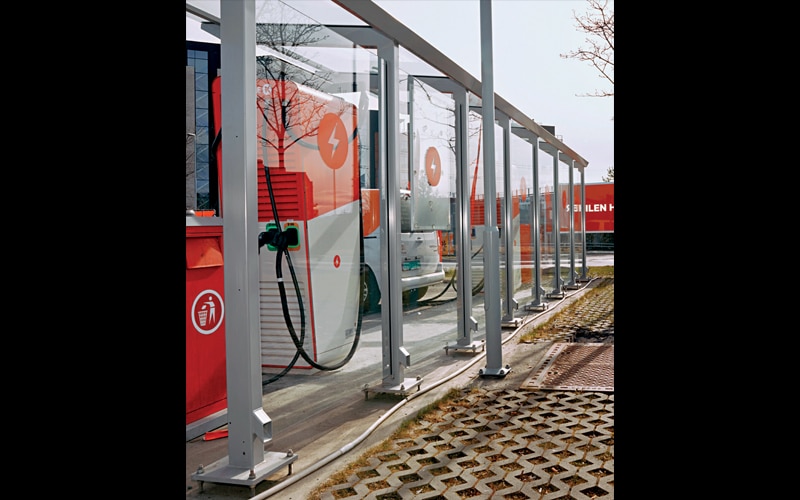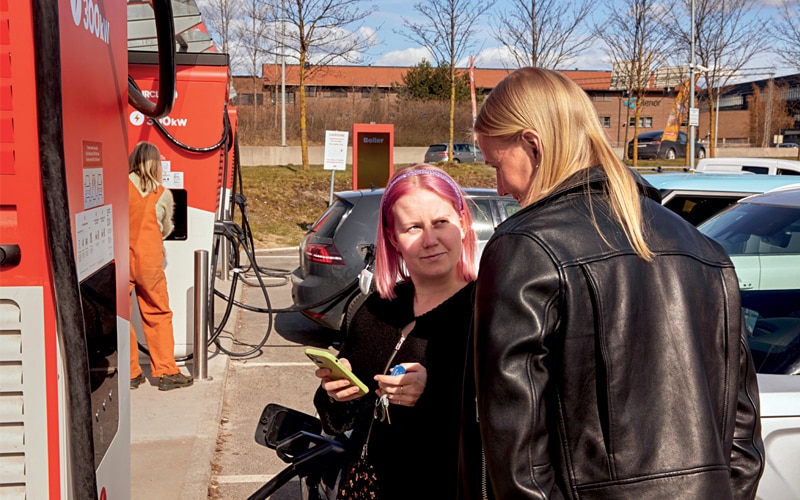- HOME
- /
- Features
- /
- Cover Story
- /
The Climate Changers: Where EVs Rule the Road
Norway has embraced battery-powered vehicles. The air is cleaner, the streets are quieter and the electrical grid hasn’t collapsed.
 David B. Torch/The New York Times
David B. Torch/The New York Times
About 177 kilometers south of Oslo, along a highway lined with pine and birch trees, a shiny fuelling station offers a glimpse of a future where electric vehicles rule. Chargers far outnumber gasoline pumps at the service area operated by the retail chain Circle K.
Marit Bergsland, who works at the store, has had to learn how to help frustrated customers connect to chargers in addition to her regular duties flipping burgers and ringing up purchases. “Sometimes we have to give them a coffee to calm down,” she says.
In 2023, 82 per cent of new-car sales in Norway were electric, putting the country at the vanguard of the shift to battery-powered mobility. It has also turned Norway into an observatory for figuring out what the electric vehicle revolution might mean for the environment, workers and life in general. The country has set a goal of ending all sales of new cars powered by internal combustion engines this year.
Norway’s experience suggests that electric vehicles bring benefits without the dire consequences predicted by some critics. There are problems, of course, including unreliable chargers and long waits during periods of high demand. The switch has reordered the auto industry, making Tesla the best-selling brand and marginalizing established carmakers like Mitsubishi, Peugeot and Ford.
 An electric vehicle charging station in Økern, Norway. Photo credit: David B. Torch/The New York Times
An electric vehicle charging station in Økern, Norway. Photo credit: David B. Torch/The New York Times
But the air in Oslo, Norway’s capital, is measurably cleaner. And as noisier gasoline and diesel vehicles are scrapped, the city is quieter. Oslo’s greenhouse gas emissions have fallen 28 per cent since 2009, yet there has not been mass unemployment among gas station workers and the electrical grid has not collapsed.
Some lawmakers and corporate executives portray the fight against climate change as requiring grim sacrifice. “With EVs, it’s not like that,” says Christina Bu, secretary general of the Norwegian EV Association, which represents EV drivers. “It’s actually something that people embrace.”
Norway began promoting electric vehicles in the 1990s. Battery-powered vehicles were exempted from value-added and import taxes and from highway tolls, and taxes on fossil fuel–powered cars were increased. The government also subsidized the construction of the first fast-charging stations. The combination of incentives and ubiquitous charging “took away all the friction factors,” says Jim Rowan, the chief executive of Volvo Cars, based in neighboring Sweden.
A few meters from a six-lane highway that skirts Oslo’s waterfront, metal pipes jut from the roof of a prefabricated shed. The building measures pollution from the traffic zooming by, a stone’s throw from a bicycle path and a marina.
Levels of nitrogen oxides, byproducts of burning diesel and gasoline that cause smog and exacerbate asthma and other respiratory ailments, have fallen sharply as electric vehicle ownership has risen. “We are on the verge of solving the NOx problem,” says Tobias Wolf, Oslo’s chief engineer for air quality, referring to nitrogen oxides.
But there is still a problem where the rubber meets the road. Oslo’s air has unhealthy levels of microscopic particles generated partly by the abrasion of tires and asphalt. Electric vehicles may even aggravate that problem. “They’re heavier than internal combustion engine cars, and that means that they can cause more abrasion,” says Wolf, who, like many Oslo residents, prefers to get around by bicycle.
Another persistent problem: Apartment residents say finding a place to plug in their cars remains a challenge. Sirin Hellvin Stav, leader of Oslo City Council’s standing committee on transport and environmental affairs, says that the city wants to install more public chargers but also reduce the car traffic by a third to make streets safer and free up space for walking and cycling.
“The goal is to cut emissions, which is why EVs are so important, but also to make the city better to live in,” says Stav, a member of the Green Party. Electric vehicles are part of a broader plan by Oslo to reduce its carbon dioxide emissions to almost zero by 2030. All city buses will be electric by the end of the year. Stav acknowledges what she calls the hypocrisy of Norway’s drive to reduce greenhouse gases while producing oil and gas. Fossil-fuel exports generated $110 billion in revenue in 2023. “We’re exporting that pollution,” Stav says.
But Norway’s government has not pulled back on oil and gas production. “We have several fields in production or under development, providing energy security to Europe,” a spokesperson for the Norwegian Ministry of Energy said in a statement.
 Guro Størdal,right, an executive with Circle K, with a customer charging her EV. Photo credit: David B. Torch/The New York Times
Guro Størdal,right, an executive with Circle K, with a customer charging her EV. Photo credit: David B. Torch/The New York Times
Norway’s power grid has held up fine, even with more demand for electricity. It helps that the country has abundant hydropower. Elvia, the company that supplies electricity to Oslo and the surrounding area, has had to install new substations and transformers in some places, says Anne Nysæther, Elvia’s CEO. But, she adds, “we haven’t seen any issue of the grid collapsing.”
Nor has there been a rise in unemployment among auto mechanics. Electric vehicles require less maintenance than gasoline cars, but they still break down. And there are plenty of gasoline cars around that will need maintenance for years. Electric vehicles are creating jobs in other industries. In Fredrikstad, 96 kilometers south of Oslo, a former steel plant has become a battery recycling centre. Workers, including some who worked at the steel plant, dismantle battery packs. A machine then shreds the packs to separate plastic, aluminum and copper from a black mass that contains crucial ingredients such as lithium, nickel, cobalt, manganese and graphite.
The factory is owned by Hydrovolt, a joint venture of Norwegian energy and aluminum company Hydro and Swedish battery maker Northvolt. It is the first of several factories Hydrovolt plans to build in Europe and the United States. The almost complete disappearance of gasoline and diesel vehicles from showrooms has reordered car dealerships. The Møller Mobility Group has long been Norway’s biggest auto retailer, with sales of US$3.6 billion in 2023 and dealerships in Sweden and the Baltic countries. Møller’s Oslo outlet is filled with electric Volkswagens like the ID.4 and the ID.Buzz. There are only a few internal combustion cars.
Yet Tesla is greatly outselling Volkswagen in Norway, grabbing 20 per cent of the market compared to 12 per cent for Toyota and 11 per cent for Volkswagen and its Skoda and Audi brands, according to the Norwegian Road Information Council. Circle K is using the country to learn how to serve electric car owners in the US and Europe. The chain, which is owned by Alimentation Couche-Tard in Canada, has more than 9,000 stores in North America and nearly 2,700 stories in Europe.
Electric vehicle owners tend to spend more time at Circle K because charging takes longer than filling a gasoline tank. That’s good for food sales. “We do see it as an opportunity,” Håkon Stiksrud, Circle K’s head of global e-mobility, says of electric vehicles. “But if we are not capable of grasping those opportunities, it quickly becomes a threat.”






